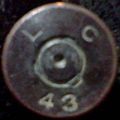| Sahuarita Air Force Range | |
|---|---|
| Sahuarita, Arizona, United States | |
 Military installations in the Tucson area during World War II. | |
| Site information | |
| Type | Training ground |
| Controlled by | |
| Location | |
 | |
| Coordinates | 31°58′N110°53′W / 31.97°N 110.88°W |
| Site history | |
| Built | 1942 |
| In use | 1942–1978 |
| Garrison information | |
| Occupants | (1942–1947) (1947–1978) |
The Sahuarita Air Force Range, also known as the Sahuarita Bombing & Gunnery Range, was built just east of Sahuarita, Arizona, in 1942. It was used for the training of bombardiers, aerial gunners, anti-aircraft gunners, and others during World War II and the Korean War. The abandoned Sahuarita Flight Strip ( 31°57′50″N110°55′29″W / 31.96389°N 110.92472°W ) is located in the southwestern corner of the range, and was used as an emergency flight strip until 1978. Before deactivation, the airspace over the range was protected by its own restricted area, R-310. [1] [2] [3]



